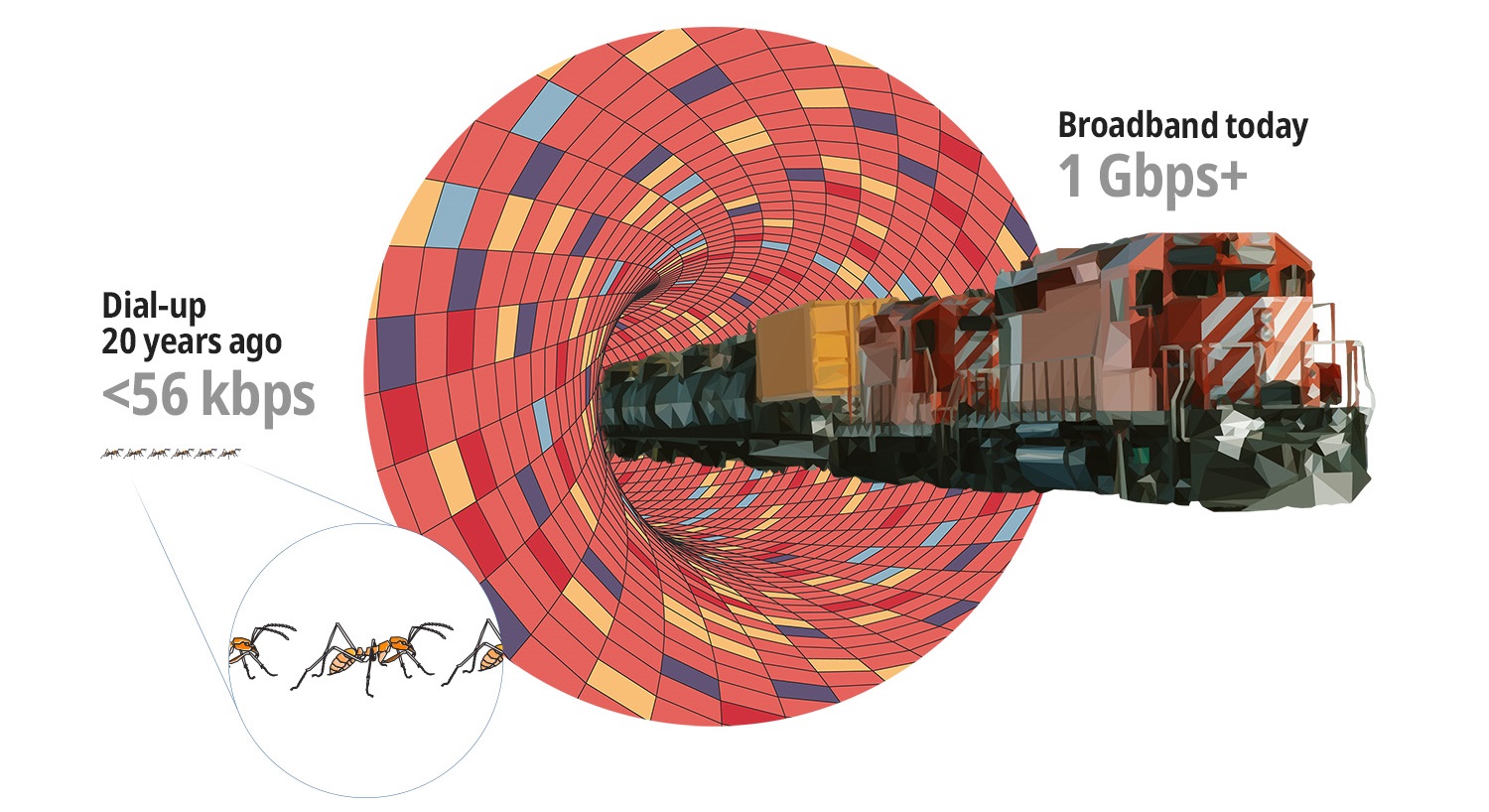더 빠른 네트워크는 더 정확한 측정을 요구합니다
2022년 6월 21일 / 일반, 표준 및 인증, 산업용 네트워크
Today’s high-tech data centers form the digital heart of communication and commerce in our world. But every industry has its “remember when” stories, and there's no better time than now to tell them.

About 20 years ago, slow dial-up connections were easy for fiber networks to manage. Today, huge volumes of data are moving along networks at gigabit-plus speeds. Ever more demanding standards and increasingly accurate measurements help data centers keep it all running smoothly.
When Internet Traffic Was Slow & Easy
Once upon a time—about 20 years ago—the most common uses for the internet among U.S. adults were low volume, slow, and largely text based: sending email and messages, browsing product and service listings, and looking at news, weather and sports. A little more than half of working adults were using a computer and/or email and internet at work. About 80% of users had dial-up connections over phone lines; private households might have a single internet-capable device (a PC).
The requirements for fiber cable and network performance were more relaxed then, too. Fiber cabling standards allowed signal loss of about 10dB, good enough to support the prevailing applications. Internet data traffic loads were organized but small and light—like a line of ants marching along.
Now Everyone Is Online All the Time
Today’s network demands are different in almost every way. About 93.0% of all Americans are going online regularly; as many as 31% of adults say they’re online “almost constantly.” Everyone is doing everything online: watching video, group messaging, file sharing, gaming in real time, streaming music, making and taking live video calls for work and school, uploading, downloading, browsing bandwidth-intensive social sites, and more. Most commercial and residential locations now host multiple devices, many with applications that are “always on”: computers, phones, tablets, routers, TVs, smart speakers and doorbells, monitoring cameras, connected appliances, phone-enabled watches, and more—all contacting data centers multiple times every hour (or more) to perform their assigned tasks.
All this digital traffic travels at a median mobile speed of 53.31 Mbps, and a median fixed connection speed of 134.10 Mbps, much of it including wireless connections to the end user. That’s at least 1,000 times faster than 20 years ago.
The load is handled by complex, sophisticated networks and data centers that the dial-up crowd couldn’t have imagined. The data center construction market in the fastest-growing region alone (Asia Pacific) was nearing $200B annually by 2020—almost as much as Amazon’s annual sales.
How Data Centers Stay Ahead
This explosion in demand for both volume and speed keeps data centers and service providers on their toes—streaming feature-length 4K video, sending billions of secure financial transactions, and carrying live audio & visuals for multi-user conference calls (to name a few common data demands) requires rock-solid cable and network performance.
Data centers have stayed ahead of the curve by increasing their highest performance capabilities from 1 gigabit per second to 800 gigabits per second—more than 10,000 times faster than the median mobile speed that end users experience. To enable that blistering speed, industry standards have advanced; where once ~10 dB signal loss was easily acceptable, today’s systems require less than 2 dB.
From Standards to Measurements, Every Part Must Fit
Every component and part in a data center must fit together and work accurately and reliably, from the industry standards that define the equipment to the measurement tools used to manufacture, install, certify, test, and troubleshoot those systems.
The engineers and metrologists at Fluke Networks have been part of developing and updating the standards that allow network and fiber cable components from different manufacturers to work together reliably. Over the past 20 years, our experts have actively participated in over 30 standards efforts, including those of the Telecommunications Industry Association (TIA), the International Organization for Standardization (ISO), and the Institute for Electrical and Electronic Engineers (IEEE). In fact, this year the TIA recognized Seymour Goldstein, engineering fellow/principal engineer in the Advanced Development Group at Fluke Networks, with a TIA Star Award for being in the top 5% of individual TIA participants for engagement, leadership, and contribution across all TIA committees.
Fluke Networks creates the test and measurement equipment that meets or exceeds those professional standards—but building an accurate tester is just the start. It's also critical that the tester provide reliably accurate measurements for many years. So we have service centers around the world that can calibrate our testers and trace their measurements back to our primary standards lab in Everett, Washington, USA. Fluke Networks tools have earned the trust of the trained technicians and electricians who install, test, and certify new and upgraded network systems—and who go in to troubleshoot when something goes wrong. They know they can rely on Fluke Networks today… and tomorrow, too.




